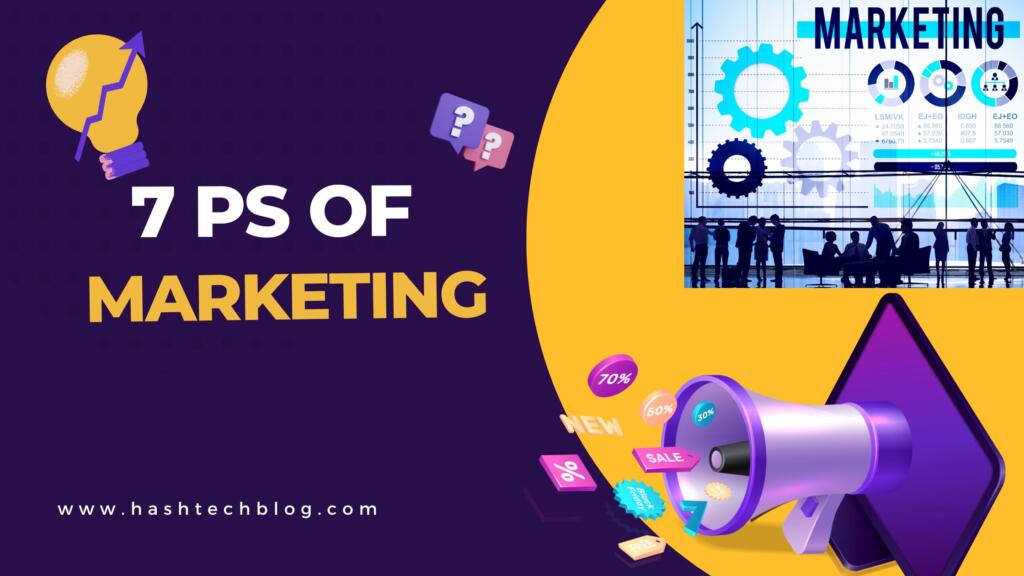Intro:
In the 1960’s the 4 Ps of marketing have been introduced by E. Jerome McCarthy to support the marketing strategies which are known as Product, Price, Place, and Promotion. Then Boom and Binters joins the party with the addition of three more Ps of marketing which are People, Process and Physical Evidence. These 7 Ps of marketing are the must-have strategies for a business to advertise a product or service.
It is essential for businesses to carefully consider each of the 7 Ps when developing their marketing strategies. Failure to address any of these elements can result in a suboptimal customer experience, reduced sales, and a weaker brand image. By adopting and applying each of the 7Ps, businesses can create a holistic marketing strategy that effectively communicates their value proposition, differentiates them from competitors, and drives growth.
The 7 Ps of marketing is a method that helps marketers create and implement effective strategies to attract and engage customers, motivate sales, and increase revenue. The method was created by E. Jerome McCarthy in 1960 and consists of seven distinct principles that can be applied to various projects and industries. The 7 Ps of marketing are:
– Product
– Price
– Place
– Promotion
– People
– Process
– Physical evidence
In this blog post, we will dig deep into each of these principles means, why they are important and how they can help you achieve your marketing goals in 2023.
7 Ps of Marketing in the Digital Era of social media

In the dynamic digital era of social media today in 2023, the 7 Ps of Marketing holds paramount significance. Product differentiation becomes essential to capture the attention of tech-savvy consumers amidst intense competition. Effective pricing strategies must be devised to entice the online audience and optimize profitability.
Promotion gains new dimensions through targeted advertisements, influencer collaborations, and viral campaigns. Place evolves to encompass virtual marketplaces, e-commerce platforms, and seamless digital experiences. The 7 Ps serve as the compass guiding marketers through this ever-evolving landscape, enabling them to thrive in the digital realm of social media.
- Product
The product is the physical good or service that you offer to your customers. It should solve a problem or satisfy a need that your customers have. The product should also have features and benefits that make it stand out from the competition and appeal to your target market.
To create a successful product, you need to conduct market research, understand your customers’ preferences and expectations, design and develop your product according to their needs and wants, test and improve your product based on feedback and launch your product with a clear value proposition.
Here are the key features to consider in Market mix Strategies:
What people expect from particular Product or Service?
How to fulfill the client’s requirements?
What change that product will bring in their life?
Some examples of product strategies in the digital marketing mix are:
– Using SEO to optimize your product pages for relevant keywords and increase organic traffic
– Writing blogs or articles that showcase your product’s features, benefits and use cases
– Incorporating influencer marketing to leverage the credibility and reach of popular personalities who endorse your product.
- Price
The price is the amount of money that you charge for your product or service. It should reflect the value that your product or service provides to your customers, as well as your costs, profit margin and competitive position.
To set a suitable price, you need to analyze your costs, competitors, customers and market conditions. You also need to consider different pricing strategies, such as cost-based, value-based, competition-based or dynamic pricing. You should also monitor your sales performance and customer feedback to adjust your price accordingly.
So, it’s important to set the price right to not only bear costs but to generate profit as well. Sometimes the change in your terms and conditions of sales can work for you.
Some examples of price strategies in the digital marketing mix are:
– Creating a subscription option for your product or service that provides a discount or added value to loyal customers
– Using email marketing to offer coupons and discounts to potential or existing customers
– Implementing dynamic pricing to change your price based on demand, supply or other factors
- Place
The place is where you distribute and sell your product or service to your customers. It should be convenient, accessible and suitable for your target market. The place can be a physical location, such as a store or an office, or a digital platform, such as a website or an app.
To choose the right place, you need to understand your customers’ buying behavior, preferences and habits. You also need to evaluate different distribution channels, such as direct or indirect, online or offline, exclusive or intensive. You should also optimize your place for customer satisfaction, retention and loyalty.
These key features can assist you in defining these marketing strategies:
- The right place where the purchaser seeks your product.
- Find out the best distribution channel.
- Figure out your distribution strategies from that of your competitors.
- Hire a sales team if necessary.
- Presence on the internet to sell your product.
Some examples of place strategies in the digital marketing mix are:
– Creating an e-commerce website that allows customers to browse, compare and buy your products online
– Using social media platforms to showcase your products, interact with customers and drive traffic to your website
– Partnering with retailers or distributors who can sell your products to a wider audience or a specific niche
- Promotion
Promotion is how you communicate and promote your product or service to your customers. It should inform, persuade and remind them of the value and benefits of your product or service. The promotion can include various methods and tools, such as advertising, public relations, sales promotion, or personal selling.
To design an effective promotion strategy, you need to define your marketing objectives, identify your target audience, select the appropriate media channels, craft compelling messages and measure the results of your campaigns.
Some examples of promotion strategies in the digital marketing mix are:
– Creating online ads that target specific segments of customers based on their demographics, interests or behavior
– Developing press releases or case studies that highlight your product’s achievements, awards or testimonials
– Organizing contests or giveaways that encourage customers to engage with your brand and share it with others
- People
The people are the human resources that are involved in delivering your product or service to your customers. They include yourself, your employees, your partners and your suppliers. They should be skilled, trained, motivated and customer-oriented.
To manage your people effectively, you need to recruit, train and retain the right talent for each role. You also need to establish a positive organizational culture that fosters teamwork, innovation and excellence.
Businesses are dependent on the individuals who manage them. Employee appearance, employee performance and customer services are all important. Establishing what aggregate the appropriate people for your company might be difficult but the following factors should be included:
- Unprecedented Enthusiasm
- Noteworthy Services
- Be open to suggestions
- Process:
The sixth “P” of marketing refers to the process that a business uses to deliver its product or service to the customer. The process includes all the activities involved in manufacturing, distributing, and delivering the product or service, as well as the customer service and support that the business provides.
The process is critical because it can impact the quality of the product or service, as well as the overall customer experience. A well-designed process can lead to efficient production, fast delivery times, and a seamless customer experience. On the other hand, a poorly designed process can lead to delays, errors, and customer dissatisfaction.
Businesses need to consider various aspects of the process, including production methods, supply chain management, quality control, and customer service. By analyzing each aspect of the process, businesses can identify opportunities for improvement and create a more efficient and effective process that enhances the overall customer experience.
- Physical Evidence:
The seventh “P” in the 7 Ps of marketing refers to physical evidence, which refers to the tangible elements that customers can see or touch. Physical evidence includes everything from the appearance of employees to the packaging and design of the product.
Physical evidence is important because it can help customers form an opinion about the quality of the product or service. For example, if a business has well-designed packaging, customers may perceive the product as higher quality than a similar product with less impressive packaging.
In addition, physical evidence can also impact the overall customer experience. For example, if a store has a clean and well-organized layout, customers are more likely to enjoy their shopping experience and feel positive about the business.
Businesses need to consider various aspects of physical evidence, including store layout, product packaging, employee appearance, and even the design of the company’s website. By paying attention to these details and creating a consistent and high-quality physical environment, businesses can enhance the customer experience and build a strong brand image.
Top of Form
Conclusion:
The 7 Ps of marketing provides a comprehensive framework for businesses to develop and implement effective marketing strategies. Each of the 7 Ps, including product, price, place, promotion, people, process, and physical evidence, plays a critical role in creating a positive customer experience and building a strong brand image to attract more buyers.
To effectively apply the 7 Ps of marketing, businesses can benefit from the expertise of a digital marketing agency. Such an agency can help businesses navigate the complex and rapidly evolving digital marketing landscape and create marketing strategies that leverage the latest technologies and best practices.
By partnering with a professional digital marketing agency, businesses can ensure that they are adopting and applying each of the 7 Ps of marketing effectively and efficiently, resulting in better ROI and sustainable growth.

